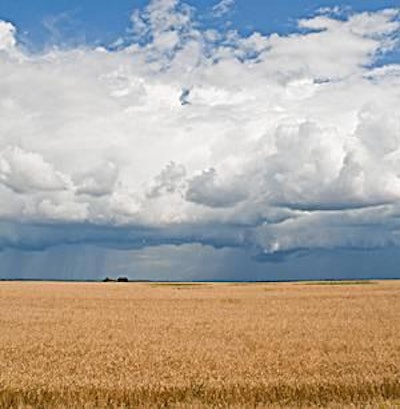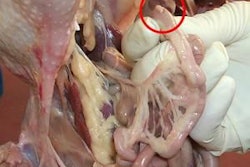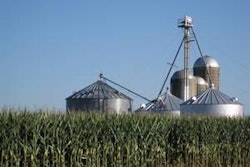
Very wet wheat, harvested after poor weather, is often unsuitable for human food uses. Such harvest conditions often result in germination and increased levels of amylase and protease. These enzymes are related to decreased loaf size and poor gluten strength in bakery products and, as a result, this damaged wheat may be sold into the animal feed market.
Wheat, and other cereals, needs to be stored at approximately 140g moisture/kg to ensure quiescence and to prevent fungal development and, consequently, drying is necessary if it is harvested wet.
Fungi are a particular problem since, not only do they utilise plant nutrients, reducing the nutritive value of the final product but, more importantly, they may produce mycotoxins, harmful to animal health and resulting in further cost implications for animal production.
Wet wheat destined for animal feed is often dried quickly, using extreme heat, to keep costs down; temperatures employed may be as high as 100ºC. The structure and composition of cereal components can be altered with thermal treatment. Often this is irreversible. It is also clear that the extent of the temperatures used and, critically, the amount of water present, define the changes that occur.
Gelatinisation
When heated past a critical temperature in excess water, native starch granules begin to absorb water and swell. Eventually the starch is ‘gelatinised’. This results in a loss of the semi-crystalline structure and solubilisation of the starch but this cannot happen if water is limiting. The melting of the crystalline structure in excess water appears to occur in one phase at temperatures above 60ºC for wheat. As moisture content decreases and becomes more limiting in the system, more heat is necessary for any structural changes to the starch.
When cereal starch is completely gelatinised, in vitro digestibility is greatly improved. The starch is soluble and enzyme access is increased. In some cases, gelatinisation of starch can increase the rate of enzyme hydrolysis 1,000-fold. To determine whether starch has been gelatinised, starch granules can be viewed under a light microscope or polarised light.
So, when cereal is harvested wet and then dried, do we bring about these changes in starch structure? In an ideal situation, wheat will be harvested after a dry summer, and will naturally reach 140g/kg moisture. However, almost all cereals will need some drying.
In practice, the higher the moisture content, the more difficult a crop is to combine as it will clog the machinery, so producers are forced to leave wet crops in the field until the moisture content begins to fall.
In the UK, for example, it is unlikely that cereal will be more than 250g/kg moisture when it is harvested, and subsequently subjected to heat treatment. It is recommended that maize be harvested at between 150 and 190g/kg moisture, however, 300-400g/kg is common. Nevertheless, a typical state diagram for starch would indicate that, to enable the crystallites to melt (at their gelatinisation temperature), the water content would have to be in excess of 500g/kg. Although the moisture content of the grains coming from the field may be high (upwards of 300g/kg), this is not sufficient to allow starch to melt when heated at 100°C. Thus it seems that only starch contained in cereals of excessive moisture content will lose structural order, gelatinise, and become more digestible. Consequently, the starch present in dried grains is rarely, if ever, gelatinised.
It should be noted that the vast majority of poultry feeds will be provided to the bird having undergone a level of processing that usually involves drying, such as pelleting, extrusion or micronisation. These latter processes have been shown to result in some degree of gelatinisation.
Second process
However, there is a second process that may need to be considered. Dry heat, which is how drying of weather damaged cereals could be described, may actually perfect the crystallinity of the starch structure, a process which is almost the reverse of gelatinisation. This could render it more resistant to subsequent melting during thermal processing (diet manufacture) and, consequently, less susceptible to enzymatic digestion by enzymes endogenous to the chick. This “perfecting” process is termed annealing.
Annealing is normally described as prolonged heating, in excess water, at just below the gelatinisation temperature of starch. However, it has also been described in situations of higher, dry heat. This may indicate that normally, high dry heat would be preferable to a slow drying at a temperature of, say, 55°C, because high temperatures over short periods are less likely to anneal starch than lower temperatures over a longer period at the same initial moisture.
Protein associated with starch may also be affected by heat treatment. The effects of temperatures between 30 and 50ºC, which were expected to be too low for any changes to the starch, have been investigated. Although no alteration was seen in starch structure, major changes occurred in the protein fraction. The studies suggested that changes in the secondary structure of proteins resulted in less water absorption, and consequently digestibility was reduced.
Do these in vitro findings transfer into the animal feed situation?
Information on drying of weather damaged wheat should not be confused with processing of cereals for animal feed, due to the extreme heat, pressure, and/or steam, which are employed in the latter. Often, treatments similar to drying are described in the literature on animal studies, however the physico-chemical changes to the components are not measured. Research has found that heat treating maize with an initial moisture content of 330-380g/kg up to 160°C did not affect chemical composition in general, but physico-chemical characteristics were not measured. The effect of drying temperature varied with maize sample.
Studies completed by the author, but not yet published, found increased starch digestibility when wheat with a starting moisture content of 250 or 270g/kg was dried either at ambient or 100°C compared to that of wheat starting at 122 or 370g/kg moisture. There was also a trend towards improved starch digestibility with drying at 100°C compared with ambient. However, microscopic imaging demonstrated that changes in starch integrity were not responsible for the observed effects on digestibility, suggesting another component was involved.
The author hypothesizes that this other component is protein associated with the starch granules. This protein could be variably affected by heat treatment, depending upon moisture content, in some cases making starch susceptibility greater.
There does not appear to be one single and conclusive effect of high drying temperature treatment on the nutritional quality of grains for poultry. Microscopy can aid in determining whether improved digestibility is due to the loss of structural integrity of starch. A potential risk is that annealing during drying may increase the subsequent gelatinisation temperature. As a result, the processed feed may be less digestible than expected. High temperature drying may also reduce starch digestibility by increasing the degree of protein association with starch. Such an effect would not be picked up through measurement of gelatinisation temperatures, but protein solubility/recovery assays should be of benefit if this were the case. Therefore, three quality parameters, microscopy, gelatinisation temperature, and protein solubility may be useful to gauge the nutritive value of a cereal as influenced by drying techniques.

















